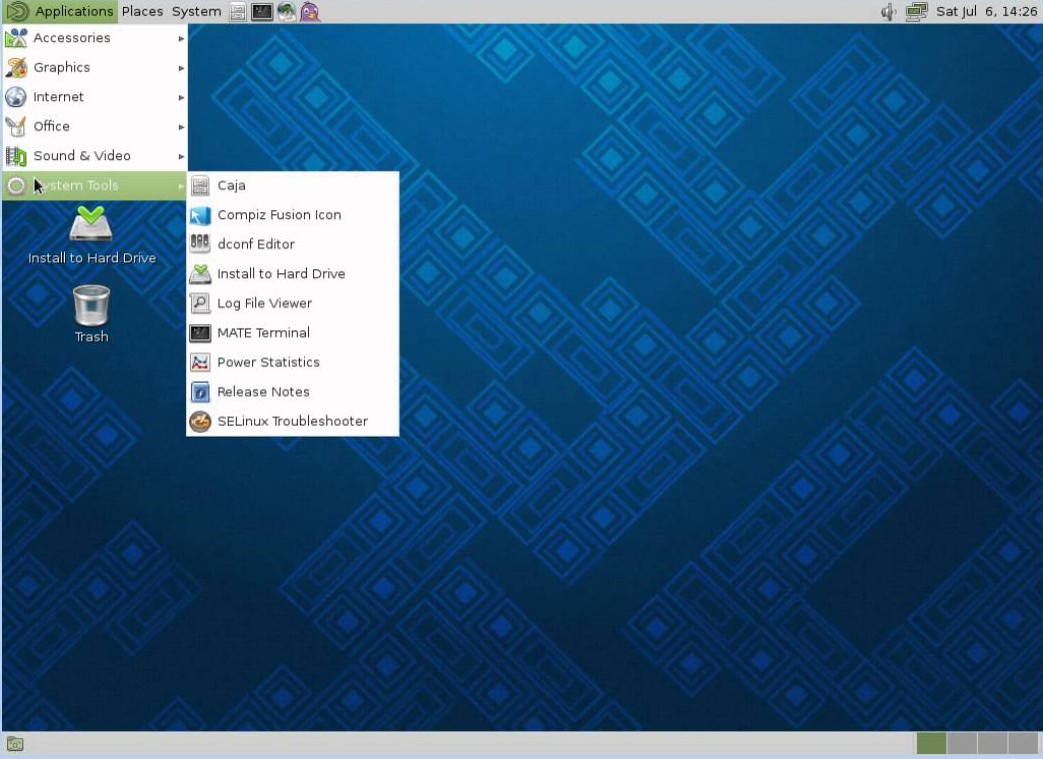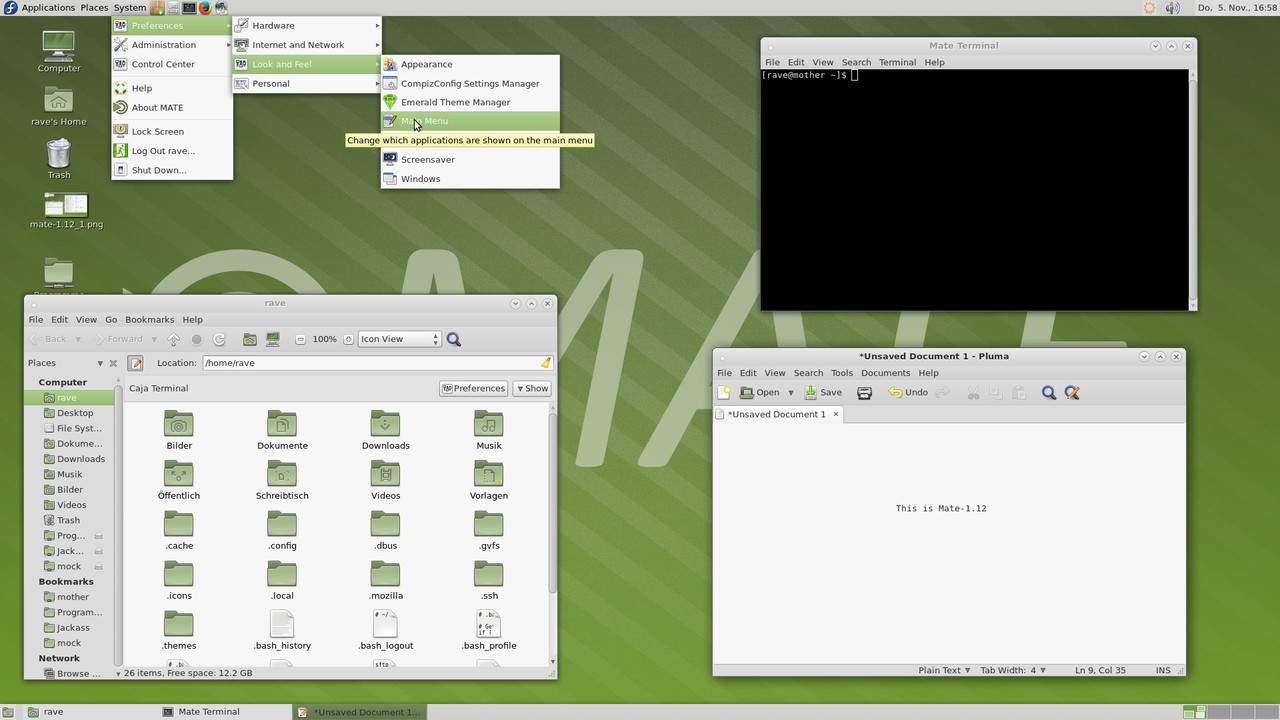Before the purists raise their fists and light the flambeau, let’s look at some reasons to have a secondary desktop in your Fedora.
- Just for fun. Because it’s nice to try new things.
- To have an alternative in case of failure. If your main desktop fails, you’ll still be able to login graphically and keep working. Alternatively, you can see what happened with your other environment.
- Refine the source of any given problem. Sometimes, an issue we think is a system problem is actually a desktop issue. It’s useful to login with another environment to see if the issue is still there or not.
For these reasons, I always have two desktops installed in my laptop. Currently these are Cinnamon (default) and Plasma 5 (alternative). But here’s another alternative: the MATE Desktop Environment
Installing MATE
Like KDE, MATE has its own spin. But if you want to install it along your current desktop, you can do it following these instructions.
First, update your system using your graphical tool, or use this command:
su -c 'dnf update'
To install everything needed, use this command:
dnf groupinstall mate-desktop
You may want to install Mate related tools as well. You can do that with this command:
dnf groupinstall mate-applications
The system will show you the amount to download and the final size once installed. If you’re okay, type y (or the equivalent for “yes” in your language). The installation itself is automatic, so you can do other things while packages install if it takes a while. If you use Terminal in a standard Fedora Workstation install, a notification sounds once the command is done. If you’re using Konsole or other tool, you may want to keep an eye on the process to know when it’s finished.
After installing your new desktop, of course you’ll want to try it. For best results, shut down your system and turn it on again. At the login screen, once you select or provide your user name, the password screen appears. There is a small gear icon which shows you options for desktop environments. Select MATE and then provide your password as usual.
Once you log in, you will find something like this:
You can play with the settings to change the appearance as you want. Anything you want to change is under the System menu which contains three separate items: Preferences, Administration, and Control Center. If you find this familiar, it isn’t a coincidence. MATE looks exactly the same as Gnome 2, from it was originally forked, and it resembles the Apple OS X style.
Under Preferences you can change GTK colors, styles, desktop themes, and icons. If you choose Control Center, you’ll launch the main program to tweak MATE. From here you can change everything about its look and feel, but you can also perform administrative tasks like configuring hardware or setting passwords.
You can find more info about MATE here at their official website. You can also visit the official Fedora MATE spin website to get an installable MATE image put together by MATE fans and contributors in Fedora.








Andrew
Thanks, what a relief: a desktop that is easy to navigate and configurable without needing 3rd party extensions that get obsoleted with every update.
Sylvia Sánchez
Yeah, that’s the idea with Mate.
If you like effects and eye candy, you can use it with Compiz, works nicely.
nicu
As someone using MATE on Fedora as my primary desktop, I unfortunately feel it less polished and more fragile (but not excessively so) compared with the last good GNOME 2, which was GNOME 2.30.
Leslie Satenstein
I evaluated Mate and then evaluated Gnome2, and never returned to Mate.
Gnome2, to me, is Mate with the convenience of good Gnome support and a few well integrated extras.
Both Mate and Gnome2 are easy to use, responsive and bug free.
A question of graphical interface adoption, in my view, is one of comfort or adaptation to it’s features.
Mate is great for some, Gnome2 for others, Plasma 5 for another group, Gnome3 for another group. Stick to one interface; be it’s promoter and expert.
nicu
How on Earth have you installed GNOME 2? It’s last release was in 2010… by now it is unmaintained and unupdated for several years
Ruben Marchese
Maybe she was talking about Gnome classic session?? or Gnome Flashback??
Anyway, using Gnome2 nowadays is kinda messy, lot of security holes, not feedback… too risky..
arehtykitna
CentOS 6.7 has GNOME 2, so it is possible to use it still with a maintained distribution even if GNOME 2 development itself has ended
nicu
Yes, CentOS/RHEL 6.x are still maintained, but talking about desktop, you don’t really want to use them, their desktop apps are just as old so you miss a lot of features.
Sylvia Sánchez
I agree with Nicu. Software, specially in Linux, add stuff every day. In all these years it’s not only you’re missing a lot of features, it’s that you’re getting a lot more bugs (that nobody fixed as it’s not longer maintained) and you take the risk of eventual security holes.
Anyway, as Leslie doesn’t explain it, I was wondering how did he/she get to keep using Gnome 2.
I prefer Mate from those anyway.
Sylvia Sánchez
I forgot to mention in the post. The origin of this desktop name is interesting:
Mate is pronounced “Mateh” because it’s a South American tree, the Ilex Paraguaiensis.
You can make a bitter drink, like a tea, with its leaves, and serve it cold or hot.
It’s usual that friends invite each other to drink this beverage, specially when they’re at home (not in a restaurant or so). It’s also used as a substitute to coffee mainly among students.
rapra
I have been using Fedora MATE as my primary desktop ever since the Gnome 3 horror show that started with Fedora 15. I am very satisfied with MATE desktop.
Sylvia Sánchez
I know, I don’t like Gnome 3 neither. That’s why I searched for another desktop and found Mate, Cinnamon. Sometimes I go back to Plasma, and I like the way it is now but it lacks of features so I’m not using it much now.
BTW, did you try Mate Compiz? I like it.
Stephen Paden
MATE is great, until you go to select it from the login screen, at which point it freezes the login process every single time.
nicu
Have you filled a bug report about it? This situation definitely do no NOT happen for a lot of other people… it would be useful to identify the root of the problem.
Sylvia Sánchez
Agree with Nicu. That’s NOT the normal behaviour, whether Mate or any other desktop as far as I know.
It would be really useful to know about your hardware, login screen and any other details. And if you can, you should file a bug. That’s the way to get things solved in the long term.
Thanks!
Keith Bellairs
Been using Mate for a couple of days. Very nice. It gets to be ridiculous learning new desktop idioms for doing the same things. Mate feels comfortable from the start.
Sylvia Sánchez
So good!
Glad this article helped you to start with Mate. And yes, you’re right, it’s very comfortable and you don’t need to learn everything again to use it. 🙂
Michael
I still prefer Gnome3.
3 questions though:
1. Why use su -c instead of sudo
2. Why use dnf update instead of dnf upgrade (thought update was deprecated alongside yum)
3. How do I safely remove MATE? I tried uninstalling mate-desktop and mate-applications via groupremove, but it also removed gnome. Would you recommend an undo on the dnf history entry?
Cheers 🙂
Justin W. Flory
Hi Michael. The first two answers are all based on preference. You can use
or
mostly just the same. The update command is aliased to upgrade.
As for removing MATE, my personal recommendation would be to just undo that specific install in your DNF history. Hope this helps!
nicu
there are a couple of answers for 1:
a) traditionally on a Fedora install one needed a few configurations (add users to the wheel group) in order to have sudo working, while su works out of the box
b) there are arguments for considering su moe secure than sudo, or at least sudo not more secure than su.
as a consequence, “su -c” is used by default in all Fedora documentation.